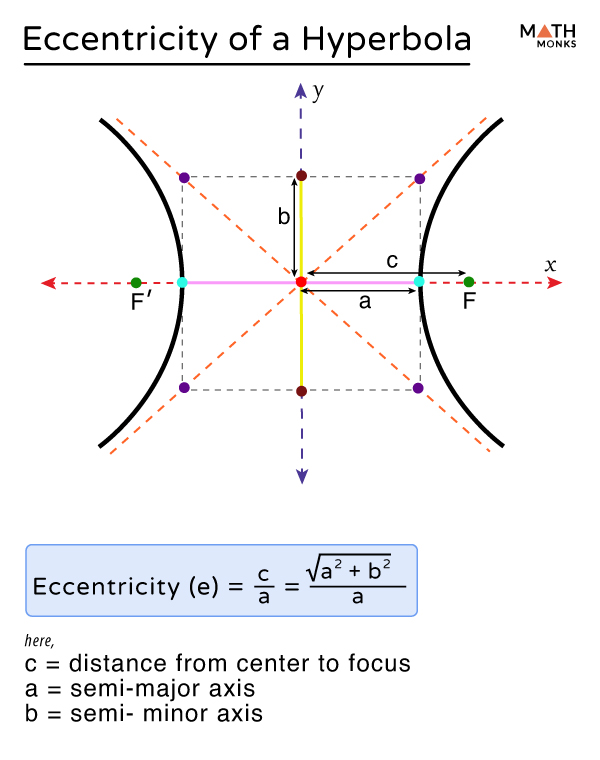The eccentricity of a hyperbola is defined as the ratio of the distance from any point on the hyperbola to its focus and the perpendicular distance from the same point to the nearest directrix.
Formula
Mathematically, the eccentricity, denoted by e, in general form, is written as:
${e=\dfrac{c}{a}}$
Here,
- c = distance from the center to the focus
- a = distance from the center to the vertex
The eccentricity of the hyperbola centered at the origin ${\dfrac{x^{2}}{a^{2}}-\dfrac{y^{2}}{b^{2}}=1}$, is given by:
${e=\dfrac{\sqrt{a^{2}+b^{2}}}{a}}$
Here,
- a = distance from the center of the hyperbola to a vertex along the transverse axis
- b = distance from the center to a point on the conjugate axis
The eccentricity of the hyperbola is always greater than 1 (e > 1), which indicates that the distance from any point on the hyperbola to its focus is always greater than the distance from that point to the corresponding directrix.
Derivation
Let us consider a point P on the hyperbola with coordinates (x, y)
From the definition of hyperbola, we know the difference in the distances between a set of points present in a plane and two foci is always constant.
If the foci of the hyperbola are F (c, 0) and F’ (-c, 0), the difference in the distance from P to the foci F and F’ is 2a
PF’ – PF = 2a …..(i)
PF’ = ${\sqrt{\left( x+c\right) ^{2}+y^{2}}}$ and PF = ${\sqrt{\left( x-c\right) ^{2}+y^{2}}}$ …..(ii)
Now, substituting the values of (ii) in the equation (i), we get
${\sqrt{\left( x+c\right) ^{2}+y^{2}}-\sqrt{\left( x-c\right) ^{2}+y^{2}}=2a}$
⇒ ${\sqrt{\left( x+c\right) ^{2}+y^{2}}=2a+\sqrt{\left( x-c\right) ^{2}+y^{2}}}$
Squaring on both sides,
⇒ ${\left( x+c\right) ^{2}+y^{2}=4a^{2}+\left( x-c\right) ^{2}+y^{2}+4a\sqrt{\left( x-c\right) ^{2}+y^{2}}}$
⇒ ${x^{2}+c^{2}+2cx+y^{2}=4a^{2}+x^{2}+c^{2}-2cx+y^{2}+4a\sqrt{\left( x-c\right) ^{2}+y^{2}}}$
Simplifying,
⇒ ${2cx=4a^{2}-2cx+4a\sqrt{\left( x-c\right) ^{2}+y^{2}}}$
⇒ ${4cx-4a^{2}=4a\sqrt{\left( x-c\right) ^{2}+y^{2}}}$
⇒ ${cx-a^{2}=a\sqrt{\left( x-c\right) ^{2}+y^{2}}}$
Again, on squaring both sides,
⇒ ${\left( cx-a^{2}\right) ^{2}=a^{2}\left\{ \left( x-c\right) ^{2}+y^{2}\right\}}$
⇒ c2x2 + a4 – 2a2cx = a2(x2 + c2 – 2cx + y2)
Simplifying further,
⇒ c2x2 + a4 – 2a2cx = a2x2 + a2c2 – 2a2cx + a2y2
⇒ c2x2 + a4 = a2x2 + a2c2 + a2y2
⇒ c2x2 – a2x2 – a2y2 = a2c2 – a4
⇒ x2(c2 – a2) – a2y2 = a2(c2 – a2)
Dividing both sides by a2(c2 – a2),
⇒ ${\dfrac{x^{2}\left( c^{2}-a^{2}\right) }{a^{2}\left( c^{2}-a^{2}\right) }-\dfrac{a^{2}y^{2}}{a^{2}\left( c^{2}-a^{2}\right) }=\dfrac{a^{2}\left( c^{2}-a^{2}\right) }{a^{2}\left( c^{2}-a^{2}\right) }}$
⇒ ${\dfrac{x^{2}}{a^{2}}-\dfrac{y^{2}}{c^{2}-a^{2}}=1}$ …..(ii)
Since we know the standard equation of the hyperbola is ${\dfrac{x^{2}}{a^{2}}-\dfrac{y^{2}}{b^{2}}=1}$ …..(iii)
Now, on comparing the equations (ii) and (iii),
c2 – a2 = b2
⇒ c2 = a2 + b2
⇒ c = ${\sqrt{a^{2}+b^{2}}}$ …..(iv)
Now, from the definition of the eccentricity, we get ${e=\dfrac{c}{a}}$ …..(v)
Now, substituting the value of c from (iv) in the equation (iii), we get
${e=\dfrac{\sqrt{a^{2}+b^{2}}}{a}}$, which is the formula to calculate eccentricity in terms of lengths of its major axis and minor axis.
Solved Examples
![]() If the hyperbola is given by the equation ${\dfrac{x^{2}}{49}-\dfrac{y^{2}}{36}=1}$, find its eccentricity.
If the hyperbola is given by the equation ${\dfrac{x^{2}}{49}-\dfrac{y^{2}}{36}=1}$, find its eccentricity.
Solution:
![]()
Given, ${\dfrac{x^{2}}{49}-\dfrac{y^{2}}{36}=1}$
As we know, the standard equation of the hyperbola is ${\dfrac{x^{2}}{a^{2}}-\dfrac{y^{2}}{b^{2}}=1}$
On comparing both equations, we get
a = 7 and b = 6
Now, the eccentricity is ${e=\dfrac{\sqrt{a^{2}+b^{2}}}{a}}$
⇒ ${e=\dfrac{\sqrt{7^{2}+6^{2}}}{7}}$
⇒ ${e=\dfrac{\sqrt{49+36}}{7}}$
⇒ ${e=\dfrac{\sqrt{85}}{7}}$
Thus, the eccentricity of the hyperbola is ${e=\dfrac{\sqrt{85}}{7}}$
![]() If the hyperbola is given by the equation ${\dfrac{y^{2}}{9}-\dfrac{x^{2}}{16}=1}$, find its eccentricity.
If the hyperbola is given by the equation ${\dfrac{y^{2}}{9}-\dfrac{x^{2}}{16}=1}$, find its eccentricity.
Solution:
![]()
Given, ${\dfrac{y^{2}}{9}-\dfrac{x^{2}}{16}=1}$
As we know, the standard equation of the hyperbola is ${\dfrac{y^{2}}{a^{2}}-\dfrac{x^{2}}{b^{2}}=1}$
On comparing both equations, we get
a = 3 and b = 4
Now, the eccentricity is ${e=\dfrac{\sqrt{a^{2}+b^{2}}}{a}}$
⇒ ${e=\dfrac{\sqrt{3^{2}+4^{2}}}{3}}$
⇒ ${e=\dfrac{\sqrt{9+16}}{3}}$
⇒ ${e=\dfrac{\sqrt{25}}{3}}$
⇒ ${e=\dfrac{5}{3}}$
Thus, the eccentricity of the hyperbola is ${e=\dfrac{5}{3}}$
![]() If the eccentricity of a horizontal hyperbola centered at (0, 0) is 2, and the semi-major axis is 8 units, find the equation of the hyperbola.
If the eccentricity of a horizontal hyperbola centered at (0, 0) is 2, and the semi-major axis is 8 units, find the equation of the hyperbola.
Solution:
![]()
Given, e = 2 and a = 8
⇒ e = 2 and a2 = 64
As we know, ${e=\dfrac{\sqrt{a^{2}+b^{2}}}{a}}$
⇒ ${2=\dfrac{\sqrt{64+b^{2}}}{8}}$
⇒ ${2\times 8=\sqrt{64+b^{2}}}$
⇒ ${16=\sqrt{64+b^{2}}}$
⇒ ${\left( 16\right) ^{2}=\left( \sqrt{64+b^{2}}\right) ^{2}}$
⇒ ${256=64+b^{2}}$
⇒ ${b^{2}=256-64}$
⇒ ${b^{2}=192}$
Since the hyperbola is centered at (0, 0) and its transverse axis is on the x-axis.
Thus, the equation of the horizontal hyperbola is ${\dfrac{x^{2}}{64}-\dfrac{y^{2}}{192}=1}$
Problem – Finding the eccentricity of a CONJUGATE HYPERBOLA
![]() If the eccentricity of a hyperbola is ${\dfrac{5}{3}}$, find the eccentricity of its conjugate hyperbola.
If the eccentricity of a hyperbola is ${\dfrac{5}{3}}$, find the eccentricity of its conjugate hyperbola.
Solution:
![]()
The sum of the square of the reciprocal of eccentricities of a hyperbola and its conjugate is 1
Given, e = ${\dfrac{5}{3}}$
If the eccentricity of the conjugate hyperbola is e1, then
${\dfrac{1}{e^{2}}+\dfrac{1}{e_{1}^{2}}=1}$
⇒ ${\left( \dfrac{3}{5}\right) ^{2}+\dfrac{1}{e_{1}^{2}}=1}$
⇒ ${\dfrac{9}{25}+\dfrac{1}{e_{1}^{2}}=1}$
⇒ ${\dfrac{1}{e_{1}^{2}}=1-\dfrac{9}{25}}$
⇒ ${\dfrac{1}{e_{1}^{2}}=\dfrac{25-9}{25}}$
⇒ ${\dfrac{1}{e_{1}^{2}}=\dfrac{16}{25}}$
⇒ ${e_{1}^{2}=\dfrac{25}{16}}$
⇒ ${e=\dfrac{5}{4}}$
Thus, the eccentricity of the conjugate hyperbola is ${e=\dfrac{5}{4}}$

